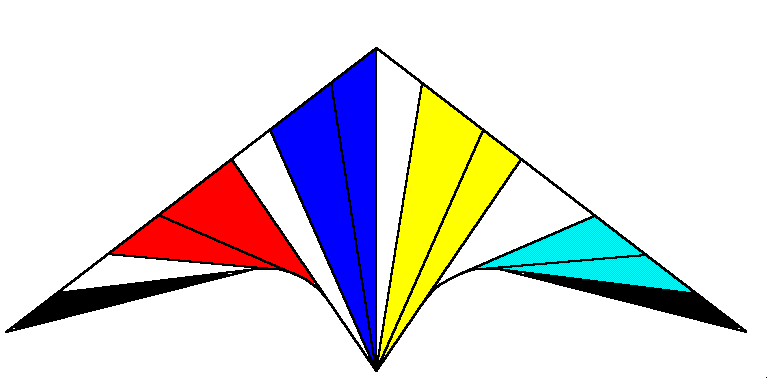

STACK has been founded in 1988 as an association for sport kite flyers all over the world. With over 600 members in over 16 countries it is not the largest, over even most wide spread kiting organisation. But it still is the only international association specifically for sport kite flyers
Sport kite flying is flying with steerable kites (kites with two or more lines), in competition.
Kite flying is a very old 'pass-time', its origin probably lies in China. All kind of shapes and sizes have been made over the centuries. Even steerable kites have been made and flown centuries ago. It is not clear how the kite came to Europe, and whether it was taken from the Japanese or the Chinese tradition.
Steerable kites were developed early 19th century in England and in the
second world war in the USA. But it really took of with the "Peter Powell" (named
after its designer from England). A simple diamond shape, but very lightly build
from fiberglass rods and plastic foil, it made it possible to let a kite do
things that were thought impossible before (which until now is one of the
characteristics of every newly designed stunt/ sport kite). A one line kite has
a 'static' position in the sky, its direction laid-up by the wind, its height a
result of form and weight. Because of the two (or more) lines a steerable kite
can fly from right to left (sometimes more than 70o) and can fly
from almost straight above your head to ground level (either landing nicely or
crashing)
From 1975 onwards stunt kite flying (thanks to the Peter Powell) rapidly
became a favourite form of kite flying for many, and it did not take long
before people tried to impress eachother with yet another stunt or trick.
Development of the Flexifoil, a stunt kite with the shape of a wing, lightly
build from nylon (or polyester) sailcloth, with just one tapered rod in front
really boosted stunt kite flying. This kite made it possible to use wind as a
motor, pulling the pilot either on foot, on wheels or in a boat. (it's shape and
it's steerability can be recognised in the modern parachute.)
First in the USA, and later in Europe people wanted to convince eachother they could do more and better tricks and stunts, and so a regulated form of competition was developed. In these competitions single pilots, but also pairs and teams fly 'routines' either 'precision' where accuracy and technical skills are of main importance, as well as 'ballet' where the pilot(s) shows that kites can 'fly on the music' . All more or less comparible with ice-dancing or synchronised swimming.
STACK has been established to coordinate competitions, provide rules and
regulations, train and provide judges and bring together competitiors and
organisers for competition-events. It keeps it's members informed about oncoming
events and new developments. It also regulates championships, (Euro-cup f.i.)
and selects the STACK teams for World Championships.
If you want to know more about sport kite flying, check your local newspaper
(although you will be lucky if a kite-festival is mentioned) or check the
STACK events page 1998 to see if there is one nearby. And
go and have a look!
There are also a (small) number of magazines that can inform
you. And of course you can try our "netlink"
page!
If you want to try yourself, there are a lot of kite-shops around. They will give you sound advise on buying and -more importantly- flying kites. Ask where other pilots fly usually and go over there to ask them "how to do it"
And if you decide to become a member of STACK please fill in the membershipform